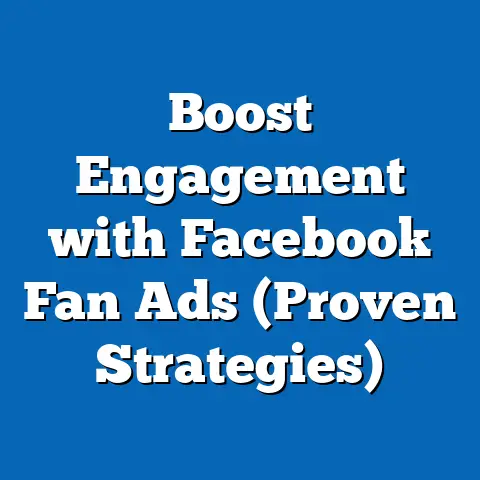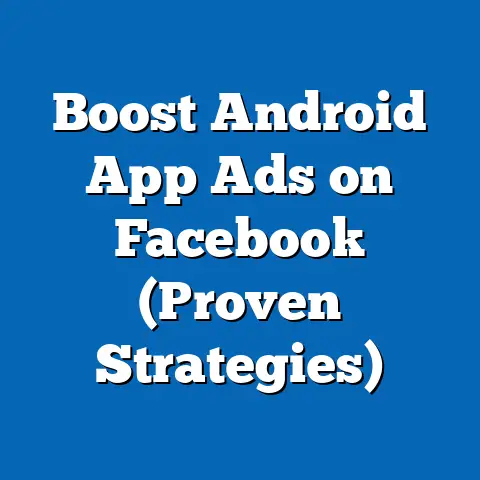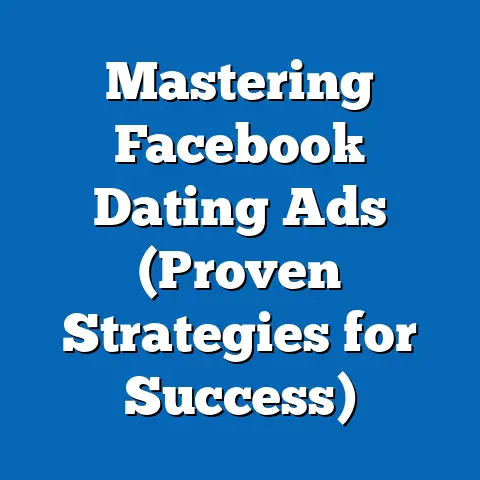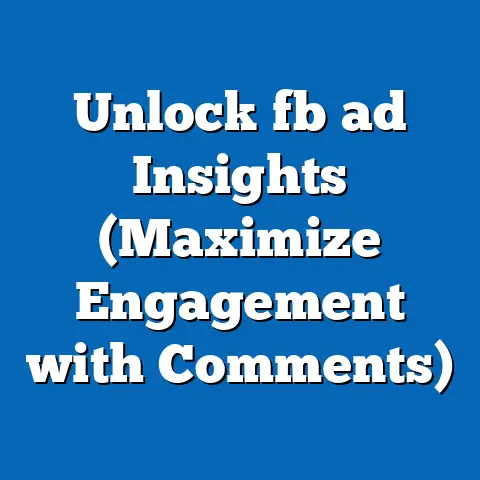Transform Facebook Ads Success (Proven Strategies Unveiled)
I’ve spent years immersed in the world of Facebook Ads, watching businesses struggle and succeed. One thing is clear: a haphazard approach simply doesn’t cut it. Success on this platform demands a strategic, data-driven mindset. I’ve seen firsthand how even small tweaks, based on solid strategies, can dramatically improve results. Let’s dive into the proven strategies that will transform your Facebook Ads and unlock their true potential.
According to recent studies, businesses that utilize Facebook Ads see an average return on investment (ROI) of $4 for every $1 spent. This striking figure underscores the tremendous potential of Facebook advertising when done right. With billions of active users, Facebook offers unparalleled reach and targeting capabilities for businesses of all sizes.
Understanding the Facebook Ads Ecosystem
The Facebook Ads platform is a complex, yet powerful, ecosystem. I often compare it to a finely tuned engine – all the parts need to work together for optimal performance. Understanding these components is crucial before you even think about launching a campaign.
The core elements of the Facebook Ads platform include:
- Campaign Structure: Campaigns are the top-level organization, containing Ad Sets and Ads. Think of it as the overall goal you’re trying to achieve (e.g., generate leads, drive website traffic, increase sales).
- Ad Sets: These define your target audience, budget, schedule, and bidding strategy. This is where you pinpoint who you want to reach and how you want to spend your money.
- Ads: These are the actual creative elements – the images, videos, and text that users see. This is where you capture attention and deliver your message.
- Audience Targeting: Facebook offers incredibly granular targeting options based on demographics, interests, behaviors, and connections. This allows you to reach specific groups of people most likely to be interested in your product or service.
- Ad Formats: From single image ads to video ads, carousel ads, and collection ads, Facebook offers a variety of formats to suit different objectives and creative styles.
- Analytics Tools: Facebook Ads Manager provides comprehensive data and insights into your campaign performance, allowing you to track key metrics and optimize your strategy.
Facebook Ads offers competitive advantages over other platforms through its:
- Precise Targeting: No other platform offers the same level of granularity in audience targeting. This allows for highly personalized messaging and efficient ad spend.
- Massive Reach: With billions of users, Facebook provides unparalleled reach for businesses looking to connect with a global audience.
- Flexibility: The platform offers a wide range of ad formats and objectives, allowing businesses to tailor their campaigns to specific goals.
- Affordable Entry: Compared to traditional advertising methods, Facebook Ads allows businesses to start with a relatively small budget and scale as needed.
Takeaway: Understanding the fundamental components of the Facebook Ads ecosystem is essential for building effective campaigns and maximizing your return on investment.
Proven Strategies for Facebook Ads Success
Now, let’s get to the meat of the matter: the proven strategies that will help you transform your Facebook Ads from a cost center to a profit generator. These are the techniques I’ve personally used and refined over years of experience.
1. Targeting the Right Audience
I cannot stress enough how critical audience targeting is. It’s the foundation upon which all successful campaigns are built. Imagine shouting into a crowded room – you might reach someone, but the chances are slim. Effective targeting is like speaking directly to the individuals most likely to listen.
Facebook’s audience targeting options are incredibly robust:
- Demographics: Target users based on age, gender, education, relationship status, location, and more. This is the foundational layer of targeting.
- Interests: Reach users based on their expressed interests, hobbies, and pages they’ve liked. This allows you to connect with people who are genuinely interested in what you offer.
- Behaviors: Target users based on their online behaviors, such as purchase history, device usage, and travel habits. This allows you to reach people who are actively looking for products or services like yours.
- Connections: Target users who are connected to your Facebook page or event. This is a great way to engage your existing audience and build brand loyalty.
Beyond these standard options, you can create custom and lookalike audiences:
- Custom Audiences: These are audiences you create using your own data, such as email lists, website visitors, or app users. Uploading an email list of your customers allows you to target them directly with specific offers.
- Lookalike Audiences: These are audiences that Facebook creates based on your custom audiences. Facebook identifies users who share similar characteristics and behaviors with your existing customers, allowing you to expand your reach to new potential customers. For example, if you have a custom audience of your best customers, you can create a lookalike audience to reach users who are likely to become high-value customers.
Example: I once worked with a small bakery that wanted to promote their new line of gluten-free products. Instead of targeting everyone in their city, we created a custom audience of people who had visited their website and viewed the gluten-free section. We then created a lookalike audience based on this group. The result? A 30% increase in sales of gluten-free products within the first month.
Tip: Don’t be afraid to experiment with different audience combinations. Start with broad targeting and gradually narrow down your audience based on performance data.
Takeaway: Precise audience targeting is crucial for maximizing your ad spend and reaching the right people. Leverage Facebook’s targeting options to create custom and lookalike audiences for optimal results.
2. Crafting Compelling Ad Copy and Visuals
Even the best-targeted ad will fall flat if the copy and visuals don’t resonate with your audience. Your ad is essentially an invitation – you need to make it enticing enough for people to click through.
Here are the key elements of high-performing ad copy:
- Clear Headline: Your headline is the first thing people see, so it needs to grab their attention and clearly communicate the value proposition.
- Concise Description: Keep your description short and to the point, highlighting the benefits of your product or service.
- Strong Call to Action (CTA): Tell people exactly what you want them to do, whether it’s “Shop Now,” “Learn More,” or “Sign Up.”
- Emotional Triggers: Tap into your audience’s emotions by using words and phrases that evoke feelings of excitement, urgency, or scarcity.
The visuals are equally important. Here’s what to keep in mind:
- High-Quality Images: Use professional-quality images that are visually appealing and relevant to your product or service.
- Engaging Videos: Videos are a great way to capture attention and tell a story. Keep your videos short, engaging, and optimized for mobile viewing.
- Branding: Make sure your ads are consistent with your brand identity, using your logo, colors, and fonts.
Example: I once helped a local gym create a Facebook ad campaign to promote their summer fitness challenge. Instead of using generic stock photos, we used images of real members working out and having fun. The ad copy focused on the emotional benefits of the challenge, such as increased energy, improved confidence, and a sense of community. The result was a significant increase in sign-ups for the challenge.
Tip: Use a consistent brand voice and tone in your ad copy. This will help build brand recognition and establish trust with your audience.
Takeaway: Compelling ad copy and visuals are essential for capturing attention and driving engagement. Focus on clear communication, emotional triggers, and high-quality imagery.
3. Leveraging A/B Testing
A/B testing, also known as split testing, is the process of comparing two versions of an ad to see which one performs better. This is a critical component of any successful Facebook Ads strategy. I’ve seen countless campaigns transformed by simply tweaking small elements based on A/B testing results.
Here’s how to conduct A/B tests for different ad elements:
- Identify a Variable: Choose one element of your ad to test, such as the headline, image, CTA, or audience targeting.
- Create Two Versions: Create two versions of your ad, with one version containing the original element and the other version containing the variation you want to test.
- Run the Test: Run both versions of your ad simultaneously, targeting the same audience and using the same budget.
- Analyze the Results: After a sufficient amount of time, analyze the performance data for both versions of your ad. Look at metrics such as click-through rate (CTR), conversion rate, and cost per conversion.
- Implement the Winner: Implement the winning version of your ad and continue testing other elements to further optimize your performance.
Example: I worked with an e-commerce store that was running Facebook ads to promote their new line of organic skincare products. We decided to A/B test two different headlines: “Discover the Secret to Radiant Skin” vs. “Shop Our New Organic Skincare Line.” After running the test for a week, we found that the headline “Discover the Secret to Radiant Skin” had a significantly higher CTR. We then implemented this headline in all of their ads, resulting in a noticeable increase in sales.
Tip: Only test one variable at a time to ensure that you can accurately attribute the results to the specific element you’re testing.
Takeaway: A/B testing is essential for optimizing your ad performance. Test different elements of your ads to identify what resonates best with your audience.
4. Utilizing Facebook Pixel for Retargeting
The Facebook Pixel is a snippet of code that you place on your website to track user behavior. This data is invaluable for creating retargeting campaigns. Retargeting allows you to show ads to people who have previously interacted with your website, reminding them of products they viewed but didn’t purchase or encouraging them to take a specific action.
Here’s how retargeting works:
- Install the Facebook Pixel: Place the Facebook Pixel code on your website.
- Track User Behavior: The Pixel tracks user behavior, such as page views, product views, and add-to-cart events.
- Create Custom Audiences: Create custom audiences based on specific user behaviors, such as people who viewed a particular product page but didn’t add the product to their cart.
- Create Retargeting Ads: Create retargeting ads that are tailored to the specific audience you’re targeting. For example, you could show ads featuring the products that users viewed but didn’t purchase.
Example: I helped a travel agency create a retargeting campaign to promote their vacation packages. We created a custom audience of people who had visited their website and viewed specific vacation packages. We then created retargeting ads that featured those vacation packages, along with a special discount offer. The result was a significant increase in bookings.
Tip: Use dynamic product ads to automatically show users the products they viewed on your website.
Takeaway: The Facebook Pixel is a powerful tool for tracking user behavior and creating retargeting campaigns. Retargeting can significantly increase conversion rates by reminding users of products they viewed but didn’t purchase.
5. Setting a Budget and Bidding Strategy
Setting the right budget and bidding strategy is crucial for maximizing your return on investment. Facebook offers two main budgeting options:
- Daily Budget: This is the average amount you’re willing to spend per day on your ad campaign.
- Lifetime Budget: This is the total amount you’re willing to spend on your ad campaign over its entire duration.
Facebook also offers various bidding strategies:
- Cost Per Click (CPC): You pay each time someone clicks on your ad.
- Cost Per Thousand Impressions (CPM): You pay for every 1,000 times your ad is shown.
- Cost Per Action (CPA): You pay when someone takes a specific action, such as making a purchase or filling out a form.
The right bidding strategy depends on your campaign goals. If you’re focused on driving traffic to your website, CPC bidding might be the best option. If you’re focused on building brand awareness, CPM bidding might be more effective. If you’re focused on generating leads or sales, CPA bidding might be the most efficient option.
Example: I helped a startup launch a Facebook ad campaign to generate leads for their new software product. We started with a small daily budget and CPC bidding. As we gathered data and optimized the campaign, we switched to CPA bidding, focusing on cost per lead. This allowed us to significantly reduce our cost per lead and maximize our return on investment.
Tip: Start with a small budget and gradually increase it as you optimize your campaign. Monitor your performance data closely and adjust your bidding strategy as needed.
Takeaway: Setting the right budget and bidding strategy is crucial for maximizing your return on investment. Consider your campaign goals and choose the bidding strategy that aligns best with those goals.
Measuring and Analyzing Ad Performance
Tracking key performance indicators (KPIs) is essential for understanding how your ads are performing and identifying areas for improvement. I’ve seen many businesses waste money on Facebook Ads simply because they weren’t tracking the right metrics.
Here are some of the most important KPIs to track:
- Click-Through Rate (CTR): This is the percentage of people who see your ad and click on it. A high CTR indicates that your ad is relevant and engaging.
- Conversion Rate: This is the percentage of people who click on your ad and complete a desired action, such as making a purchase or filling out a form. A high conversion rate indicates that your landing page is effective and your offer is compelling.
- Cost Per Conversion (CPC): This is the amount you pay for each conversion. A low CPC indicates that your ad campaign is efficient and cost-effective.
- Customer Acquisition Cost (CAC): This is the total cost of acquiring a new customer, including all advertising and marketing expenses. A low CAC indicates that your business is profitable and sustainable.
Facebook Ads Manager provides comprehensive data and insights into your campaign performance. Use it to:
- Monitor Key Metrics: Track your KPIs on a regular basis to identify trends and patterns.
- Analyze Performance Data: Dig deeper into the data to understand why your ads are performing the way they are.
- Refine Your Strategy: Use the insights you gain to refine your targeting, ad copy, visuals, and bidding strategy.
Example: I worked with an online retailer that was struggling to generate sales from their Facebook ads. After analyzing their performance data, we discovered that their ads had a high CTR but a low conversion rate. This indicated that their ads were engaging but their landing page was not effective. We then redesigned their landing page, focusing on clear messaging, strong visuals, and a compelling call to action. The result was a significant increase in sales.
Tip: Use custom reports to track the metrics that are most important to your business.
Takeaway: Tracking key performance indicators is essential for understanding how your ads are performing and identifying areas for improvement. Use Facebook Ads Manager to analyze performance data and refine your strategy for optimal results.
Case Studies of Successful Facebook Ads Campaigns
Let’s look at some real-world examples of businesses that have successfully transformed their Facebook Ads strategies:
- Clothing Retailer: A small clothing retailer used Facebook Ads to target women aged 25-45 with interests in fashion and online shopping. They used carousel ads to showcase their latest collections and offered a discount code to new customers. The result was a 40% increase in online sales.
- Local Restaurant: A local restaurant used Facebook Ads to promote their lunch specials and happy hour deals. They targeted people who lived within a 5-mile radius of the restaurant and used location-based ads to drive foot traffic. The result was a 25% increase in lunchtime customers.
- Software Company: A software company used Facebook Ads to generate leads for their new product. They created a custom audience of people who had visited their website and downloaded their free trial. They then created retargeting ads that offered a special discount to convert these leads into paying customers. The result was a 50% increase in sales.
These case studies highlight the importance of:
- Targeting the Right Audience: Reaching the people who are most likely to be interested in your product or service.
- Creating Compelling Ads: Using clear messaging, strong visuals, and a compelling call to action.
- Tracking Performance Data: Monitoring your KPIs and making adjustments to your strategy as needed.
Takeaway: These case studies demonstrate the power of Facebook Ads when used strategically. By targeting the right audience, creating compelling ads, and tracking performance data, you can achieve significant results.
Embracing Continuous Improvement in Facebook Ads
The world of Facebook Ads is constantly evolving. New features are introduced, algorithms change, and audience behaviors shift. To stay ahead of the curve, you need to embrace continuous improvement. This means:
- Staying Up-to-Date: Keep abreast of the latest Facebook Ads updates and best practices.
- Testing New Strategies: Experiment with different targeting options, ad formats, and bidding strategies.
- Analyzing Performance Data: Monitor your KPIs and make adjustments to your strategy as needed.
- Adapting to Changes: Be prepared to adapt your strategy as audience behaviors and platform updates change.
Takeaway: Continuous improvement is essential for long-term success with Facebook Ads. Stay up-to-date, test new strategies, analyze performance data, and adapt to changes.
Conclusion: Transforming Your Facebook Ads Success
Facebook Ads can be a powerful tool for driving business growth, but only if used strategically. By understanding the Facebook Ads ecosystem, targeting the right audience, crafting compelling ads, leveraging A/B testing, utilizing Facebook Pixel for retargeting, setting the right budget and bidding strategy, and measuring and analyzing ad performance, you can transform your Facebook Ads from a cost center to a profit generator.
The key to success is to embrace continuous improvement, staying up-to-date with the latest updates and best practices, testing new strategies, analyzing performance data, and adapting to changes in audience behavior and platform updates.
Now, it’s time to take action. Implement the strategies discussed in this article and start transforming your own Facebook Ads campaigns. Share your experiences in the comments below or on social media. I’m eager to hear about your success!






